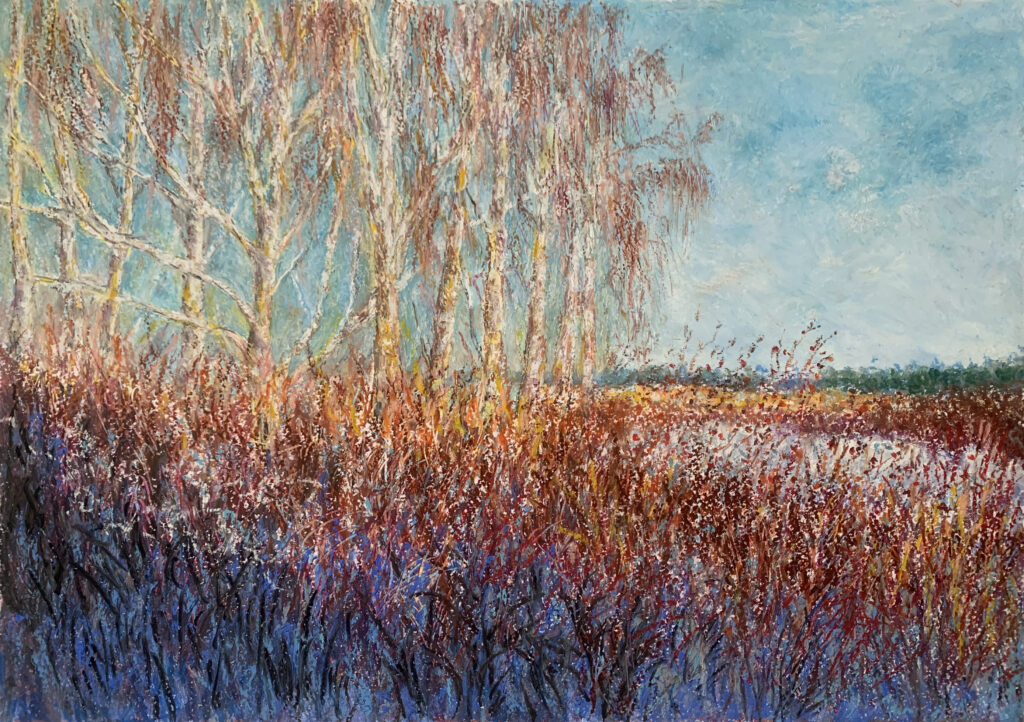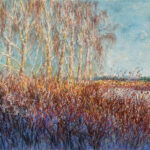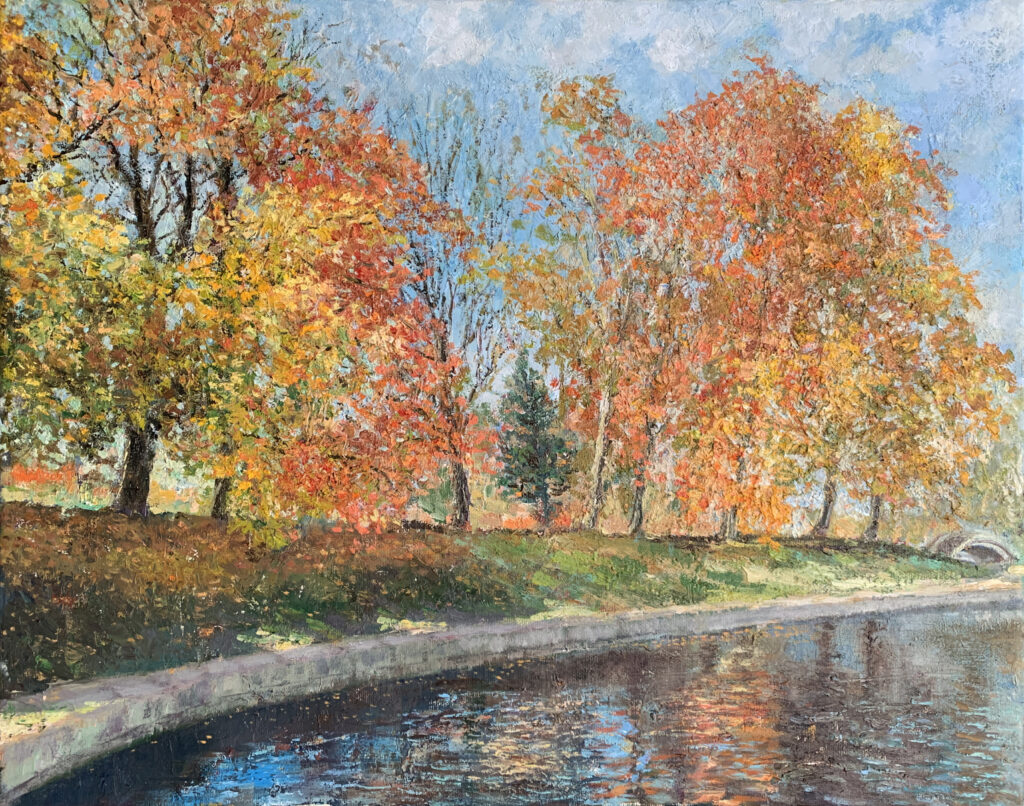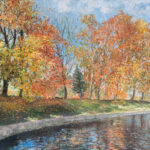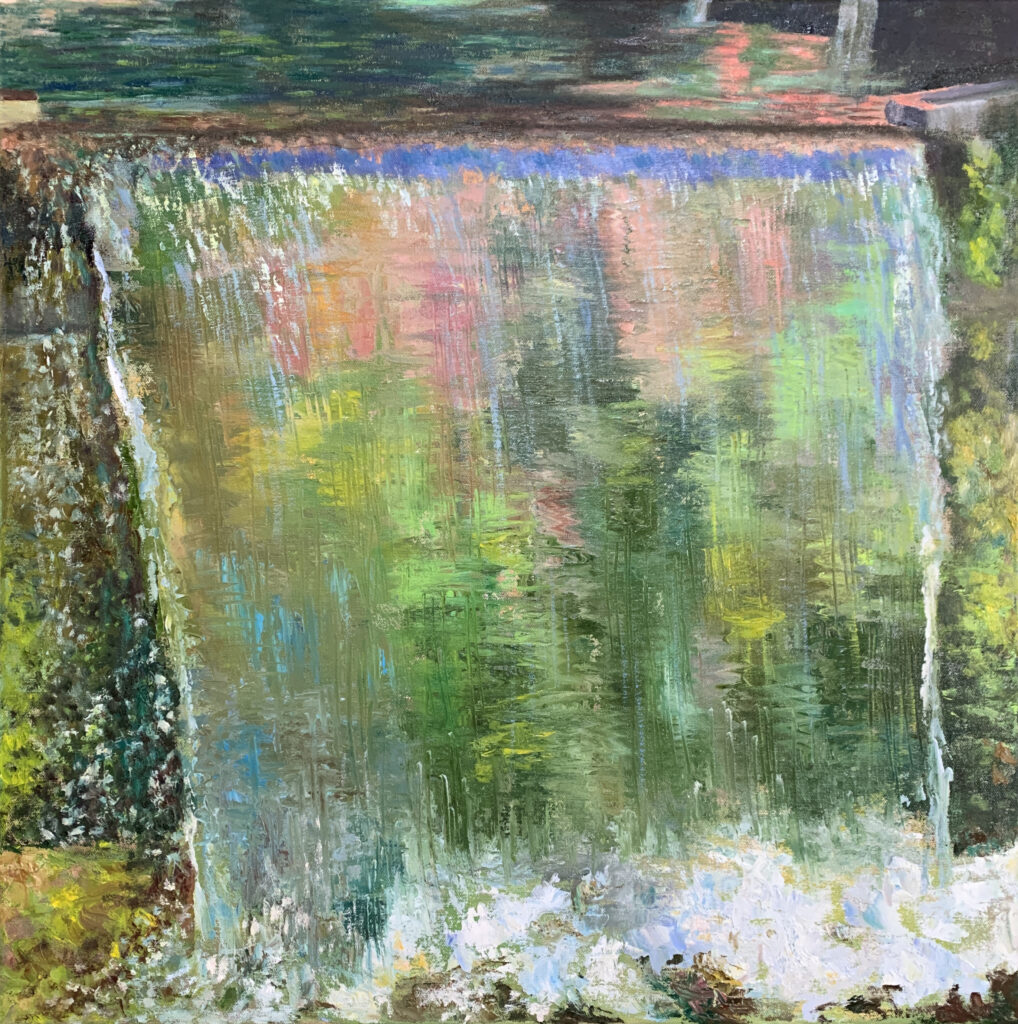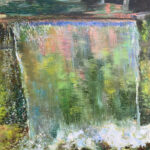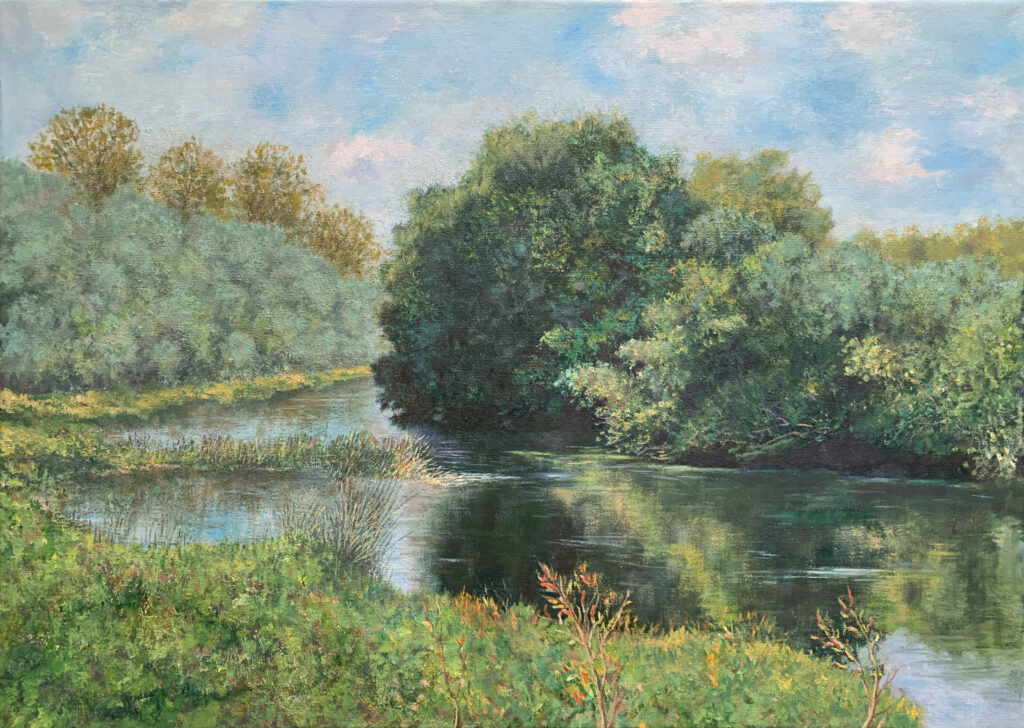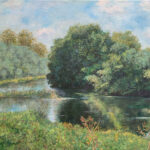Gauguin painted La Vague during his second extended sojourn in Brittany, as he availed himself of the inexpensive hospitality at Marie-Jeanne Gloanec’s pension in Pont-Aven, from late January into October 1888. The artist befriended Captain Yves-Marie Jacob, the head customs official in the town, who directed him to interesting sites along the coast. About eight miles to the southeast, in the small fishing commune of Le Pouldu, Gauguin discovered from a high, steep bluff, where the Portguerrec creek descends to the sea, this motif of massive, black lichen-covered rocks thrusting up through the North Atlantic surf. From a vantage point the artist could access only during low tide, he likely made a sketch or two, for the painting he would soon begin upon his return to Mme Gloanec’s inn. Wildenstein dates La Vague to late August or early September 1888.
Paul Gauguin (1848-1903)
La Vague (The Wave)
oil on canvas, 60.2 x 72.6 cm.
Painted in August-October 1888
Private collection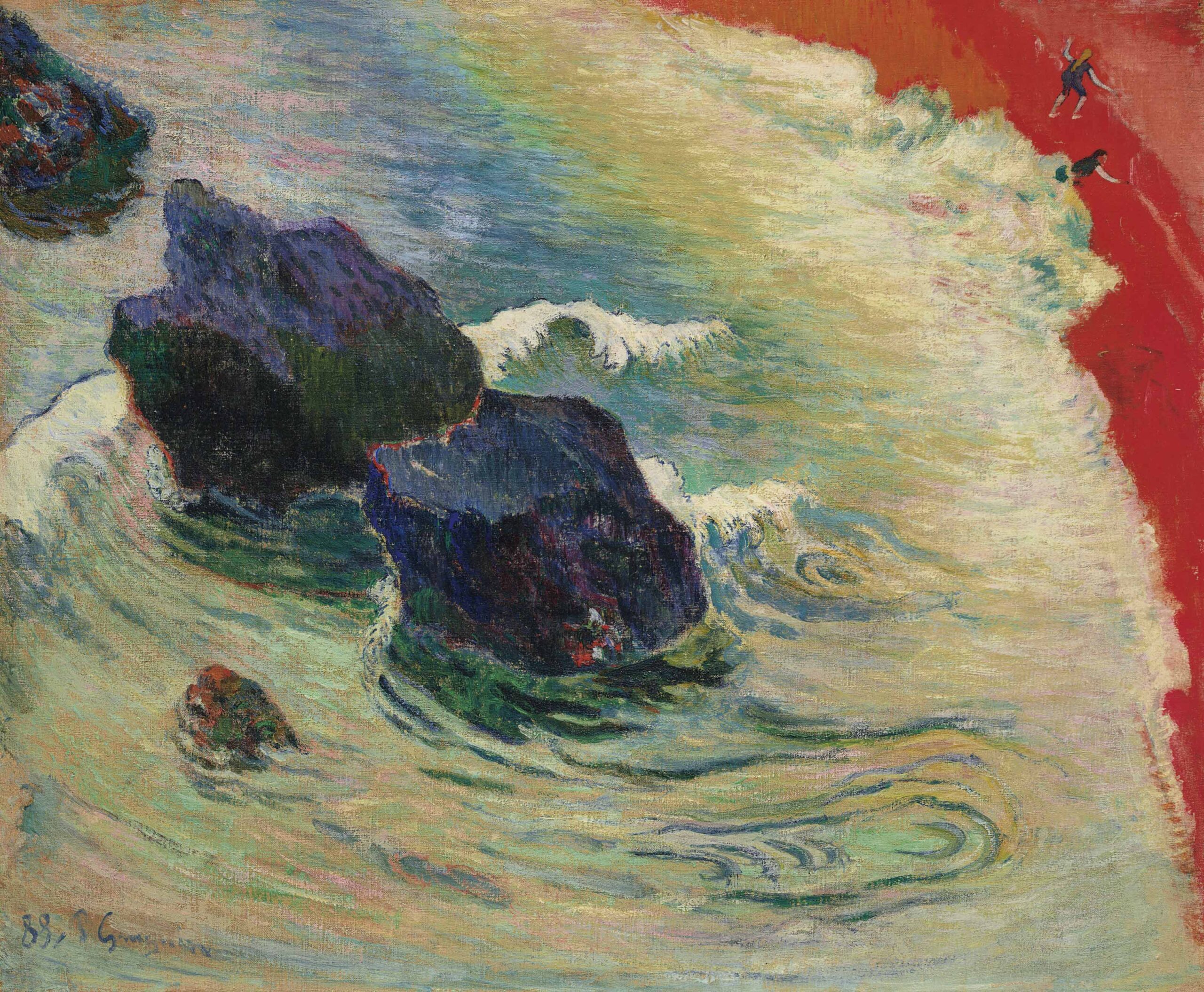
“I like living in Brittany; here I find a savage, primitive quality,” Gauguin wrote to his painter friend Claude-Emile Schuffenecker in February 1888. “When my wooden shoes echo on the granite ground, I hear the dull, muted, powerful sound I am looking for in painting” . After a slow start, Gauguin completed during the first seven months of his stay some three dozen landscapes, figure paintings, and still-lifes. These works display only hints, however, of the stylistic advances Gauguin had made during his recent stay in Martinique. He seemed hesitant to experiment, reverting instead to the Impressionist manner of his earlier work.
The catalyst for change came in the arrival of Emile Bernard, then barely twenty, who had been painting along the northern coast of Brittany and travelled to Pont-Aven at the beginning of August while on holiday with his mother and sister. Van Gogh had recommended Bernard to Gauguin; the two artists immediately hit it off. As they exchanged ideas, both men realized they were similarly seeking a new kind of expression in modern painting. “It took his meeting with Emile Bernard to put some kind of order, although yet a rather obscure one, into [Gauguin’s] mind,” John Rewald wrote. “His more or less complete assimilation of Bernard’s theories and his efforts to harmonize them with his own still vague inclinations are revealed in the artistic tenets which Gauguin now began to expound”.
Gauguin was determined to take a decisive turn in his art—he would henceforth pursue a deeply subjective, anti-naturalist, primitivist, and visionary track, in a conception he and Bernard called synthétiste. “My latest things are coming along well and I think you’ll find…the affirmation of my earlier teachings,” Gauguin wrote to Schuffenecker on 14 August. He offered this advice: “Don’t copy nature too closely. Art is an abstraction; as you dream amid nature, extrapolate art from it and concentrate on what you will create as a result ”
In keeping with these ideas, Gauguin took liberties with the marine motif he had seen in Le Pouldu. Wayne Andersen located and photographed the site. The third rock at upper left is a fiction the artist invented to extend the diagonal effect of the two actual formations. Most astonishing of all is that Gauguin painted the ordinary sand-colored beach a brilliant, utterly unnatural hue of vermilion. His increasingly idiosyncratic sense of color stemmed in part from the brilliant kiln-fired glazes that he applied to his ceramic heads and figures, in which the presence of red appears to animate the artist’s creation of flesh from clay. Gauguin’s vermilion in La Vague evokes the warmly pulsing life-blood in the generative body of maternal earth.
The red beach relates to yet another extraordinary color effect that Gauguin imposed upon this scene. For the auction of his paintings at Drouot, Paris, in February 1891, to raise funds for his imminent departure to the South Seas, Gauguin titled the present painting La Vague (arc-en-ciel). No rainbow, of course, is visible in this picture. Detectable, however, in the surging, foamy surf, is a prismatic phenomenon, in which the water appears to separate the reflected sunlight into its component chromatic wavelengths—pale violet, blue, green, and yellow—which, completed by the vermilion strand, yields a curving, rainbow-like effect along the upper edge and right-hand side of the painting. “Colors exist only in a visible rainbow,” Gauguin wrote in his Notes synthétiques of 1884-1885. “But how right rich nature was in carefully showing them to you next to each other in a deliberate and immutable order, as if each color was born of the other”.
An abiding fascination with Japanese prints surely intensified Gauguin’s affinity for the elemental power and poetic mystery he sensed in the Portguerrec rocks. He likely took the title for his canvas from Hokusai’s color woodcut The Great Wave of Kanagawa, already famous as the emblematic image for the flood-tide of japonisme that had swept through the ranks of vanguard Paris painters, and into mainstream decorative arts as well. The buyer of La Vague in the 1891 Drouot auction was the dealer Jules Chavasse, who was known for his exceptional collection of Japanese prints.
As he had observed in Japanese practice, Gauguin often composed landscapes from elevated and other unusual vantage points, allowing him to dispense with a stabilizing horizon (in contrast to Monet in his Belle-Île Rochers series, 1886), and render the motif close-up, within an unaccustomed, restricted pictorial scope. Instead of gazing into the typically broad expanse of the landscape format, the viewer in La Vague experiences a vertiginous plunge into vertical depth, the psychological effect of which is like peering into the inner recesses of one’s own emotional self.
Apart from attesting to the dating of La Vague to the later weeks of summer 1888, Gauguin’s insertion of two young female bathers, fleeing the incoming wave, may well suggest an undercurrent of sexual innuendo in the painting’s imagery. Noticing a similarity to Gauguin’s ceramic pot, self-portrait heads, and the artist’s use of his caricatured profile in Vache sur la falaise à Porsac’h, 1888, Dario Gamboni has likened the twin rocks in La Vague to “two giant heads, their faces turned upward to the sky,” and imagines “the fear caused by this apparition in the two women bathers”. Gauguin admired Breton women for their primitive, earth-motherly nature, steeped in magical Celtic legend and lore, while at the same time having his own virile impulses thwarted by the proprieties of their no less traditional, fervently devout Catholic faith.
La Vague was painted between two other notable works that bear witness to Gauguin’s recent stylistic metamorphosis and share his newfound passion for vermilion. In August 1888, the artist presented to his hostess Nature morte, fête Gloanec. The powerful, ground-breaking masterwork of Gauguin’s second stay in Pont-Aven is La vision du sermon (Jacob Wrestling with the Angel), the first symbolist painting, which Gauguin began in mid-August and completed the following month. Space in these works has become radically artificial, flat, and horizonless. The picture plane is tilted steeply toward the viewer, which verticalizes the composition of pictorial elements. The use of red in these pictures neither corresponds to, nor is derived from any observed natural phenomenon. This color is instead intended to project a visionary, revelatory state of awareness and understanding, in which a convulsive, volcanic force from within transfigures material nature into a transcendent, spiritual state.
The symbolist transformation did indeed break over Gauguin like a great wave, transporting him like a castaway to an unfamiliar shore. In two letters to Schuffenecker written a week apart in October 1888, upon the completion of La vision du sermon, the artist stated, “I wished to force myself into doing something other than what I know how to do. I believe this is a change which has not yet borne fruit, but will one day do so…Clearly the path of symbolism is full of dangers, and I have not yet ventured more than the tip of my toe in that direction: but symbolism is fundamental to my nature, and one should always follow one’s temperament…For most I shall be an enigma, but for a few I shall be a poet and sooner or later what is good wins recognition”.
Following his disastrous attempt to live and work with Van Gogh in Arles during the fall of 1888, Gauguin returned to Paris. In February 1889 the artist travelled to Brittany for this third campaign, which lasted for extended periods spread over the next two years, initially staying in Pont-Aven and thereafter in Le Pouldu, where he painted with Meyer de Haan. It was in Le Pouldu, as Rewald wrote, that “Gauguin came as close to a primitive way of life as he could ever expect to find in France”. His next destination would be half a world away—Tahiti in the South Seas.


